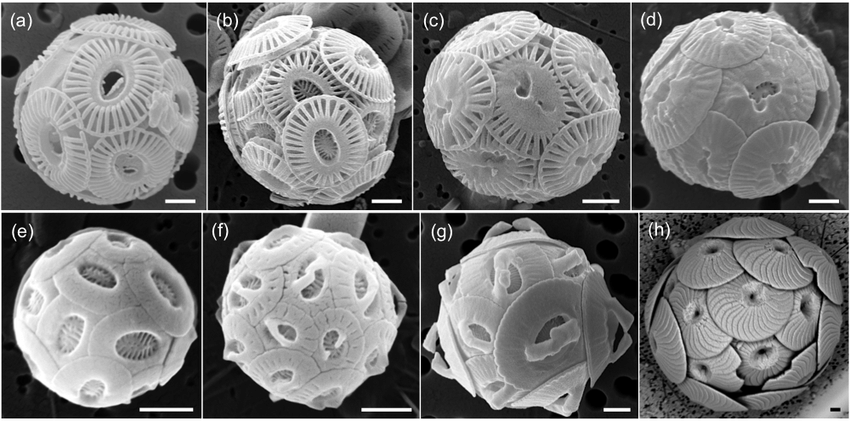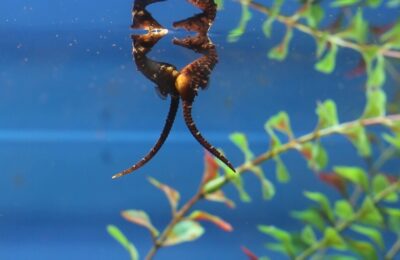Rigual Hernández, A. S., Trull, T. W., Nodder, S. D., Flores, J. A., Bostock, H., Abrantes, F., Eriksen, R. S., Sierro, F. J., Davies, D. M., Ballegeer, A.-M., Fuertes, M. A., and Northcote, L. C.: Coccolithophore biodiversity controls carbonate export in the Southern Ocean, Biogeosciences, 17, 245–263, https://doi.org/10.5194/bg-17-245-2020, 2020.
The Basics: What are Coccolithophores?
Coccolithophores (aka coccoliths) are single cell phytoplankton (primary producers) that use carbon to build their shells. The abundance and diversity of coccolithophores have a complex relationship with carbon cycling in the marine environment. Since they build their shells out of calcium carbonate or calcite (CaCO3), they can sequester carbon as they photosynthesize. After they die, the coccoliths sink and the carbon is transported to the deep ocean where it remains until a current brings it back to the surface. The authors of this study were curious about how changes in coccolith abundance and species diversity in the Southern Ocean may influence carbon sequestration and removal (or export) from the surface ocean.

The Experiment: Measuring Coccoliths
The scientists conducted their research at the Australian Southern Ocean Time Series (SOTS) observatory and the New Zealand Subantarctic Mooring (SAM) site, both of which can be found in the Subantarctic Zone (SAZ). Figure 1 provides a detailed map of the region where the field research was carried out as well as the chlorophyll concentrations for the area. The high chlorophyll concentrations are generally associated with high concentrations of coccoliths, since they produce chlorophyll as they photosynthesize. In order to quantify the abundance and diversity of coccoliths, the scientists constructed conical traps and placed them at different depths at each site in hopes of collecting all the different species of coccoliths as they sank to the sea floor. After a year of collecting samples, the authors processed and analyzed them to estimate the species present and establish a relationship between coccolith mass and the average density of calcite per coccolith.

The Results: Coccoliths & Carbon
Through their analysis of the samples the authors were able to come up with several conclusions about how coccoliths control carbon export in the marine environment:
- The dominant coccolith species in the Southern Ocean is called E. huxleyi, and it is responsible for most of the carbon sequestration in the SAZ.
- The coccoliths are susceptible to top-down effects, such as grazing from zooplankton, which can limit their abundance and productivity.
- Coccolith abundance is highest in the summer, but the peak production occurred one week earlier at the SAM site than the SOTS site.
- Coccolith abundance is heavily dependent on sea surface temperature.
- Coccoliths account for 40-60% of carbon export at the SOTS site and 15-25% of carbon export at the SAM site.
Moving Forward: Carbon Cycling in a Warming World
The authors caution that most of the environmental analyses they performed were in a lab setting, and the data they were able to collect were primarily observational. They call for more observational data, the use of paleoecological data, and surveys throughout the Southern Ocean so that more precise predictions can be made for future carbon fluxes in the marine environment. As the circumpolar currents shift due to climate change, the abundance of coccoliths could change in response. This article highlights a paper that suggests some phytoplankton may be more prepared than others. With the rapid warming of the Southern Ocean, the authors are concerned that coccoliths will face challenges producing calcite as acidification increases. They predict that coccoliths will be able to increase their range by expanding southward toward the pole, but their abundance will decrease as acidification inhibits their ability to utilize carbon in their shells. This could have drastically slow carbon sequestration and transport to the deep ocean, while perpetuating ocean acidification at the same time.
I recently graduated with a degree in Environmental Earth Science and Sustainability from Miami University of Ohio, and I recently started my MSc at the University of Victoria. While my undergraduate research focused on biogeochemical cycles in lakes and streams, I am excited to pursue my MSc in the El-Sabaawi Lab and explore how urbanization might impact fisheries. In my free time, I love to travel to somewhere off the beaten path, read fantasy novels, try new recipes, and plan my next trip to the ocean.


